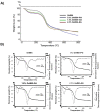UV-polymerizable methacrylated gelatin (GelMA)-based hydrogel containing tannic acids for wound healing
- PMID: 37474880
- PMCID: PMC10624738
- DOI: 10.1007/s13346-023-01383-y
UV-polymerizable methacrylated gelatin (GelMA)-based hydrogel containing tannic acids for wound healing
Abstract
Gelatin-based photopolymerizable methacrylate hydrogel (GelMA) is a promising biomaterial for in situ drug delivery, while aqueous extract of Punica granatum (AEPG) peel fruit rich in gallic acid and ellagic acid is used to improve wound healing. The aim of this study was to develop and analyze the healing properties of GelMA containing AEPG, gallic acid, or ellagic acid in a rodent model. GelMA hydrogels containing 5% AEPG (GelMA-PG), 1.6% gallic acid (GelMA-GA), or 2.1% ellagic acid (GelMA-EA) were produced and their mechanical properties, enzymatic degradation, and thermogravimetric profile determined. Wound closure rates, healing histological grading, and immunohistochemical counts of myofibroblasts were assessed over time. The swelling of hydrogels varied between 50 and 90%, and GelMA exhibited a higher swelling than the other groups. The GPG samples showed higher compression and Young's moduli than GelMA, GGA, and GAE. All samples degraded around 95% in 48 h. GPG and GGA significantly accelerated wound closure, improved collagenization, increased histological grading, and hastened myofibroblast differentiation in comparison to the control, GelMA, and GEA. GelMA containing AEPG (GPG) improved wound healing, and although gallic acid is the major responsible for such biological activity, a potential synergic effect played by other polyphenols present in the extract is evident.
Keywords: GelMA; Gelatin methacryloyl hydrogel; Iridoids; Punica granatum aqueous extract; Wistar rats.
© 2023. The Author(s).
Conflict of interest statement
The authors declare no competing interests.
Figures





References
-
- Obagi Z, Damiani G, Grada A, Falanga V. Principles of wound dressings: a review. Surg Technol Int. 2019;35:50–57. - PubMed
Publication types
MeSH terms
Substances
LinkOut - more resources
Full Text Sources

